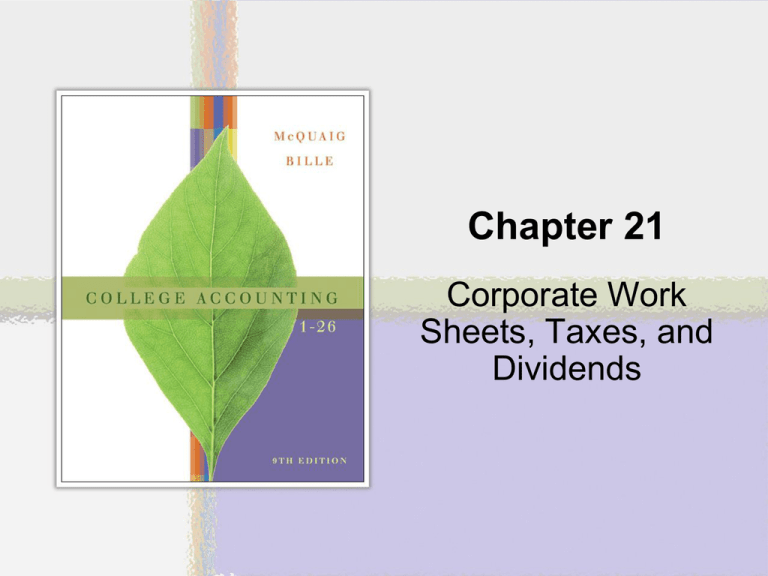
Chapter 21
Corporate Work
Sheets, Taxes, and
Dividends
Dividends for Stockholders
at Sony Corporation
• Sony believes that
continuously increasing
corporate value and
providing dividends is
essential to rewarding
stockholders.
• Dividends of 25 ¥ (yen)
per share were paid to
stockholders in fiscal
year 2006.
© Royalty Free PhotoDisc Blue/ Getty Images
Copyright © Houghton Mifflin Company. All rights reserved.
21 | 2
Corporate Income Taxes
• Because the corporation is a separate legal
entity, it must pay federal and applicable state
income taxes.
• Revenue – Expenses = Income Before Income
Tax
• Income Before Income Tax × Tax Rate =
Income Tax Expense
Copyright © Houghton Mifflin Company. All rights reserved.
21 | 3
Procedure for Recording
and Paying Income Taxes
• A corporation has to estimate the federal income
tax that it will have to pay for the forthcoming
year (pay-as-you-go basis).
• The estimate is paid in four quarterly
installments.
• The entry when each installment is paid is:
– Debit to Income Tax Expense
– Credit to Cash
Copyright © Houghton Mifflin Company. All rights reserved.
21 | 4
Procedure for Recording
and Paying Income Taxes (cont’d)
• At the end of the year, when the exact amount
of taxable income is known, an adjusting entry
is made.
– If underpaid:
• Debit to Income Tax Expense
• Credit to Income Tax Payable (current liability
account; the liability must be paid within 2 ½
months)
– If overpaid:
• Debit to Prepaid Income Tax (current asset
account)
• Credit to Income Tax Expense
Copyright © Houghton Mifflin Company. All rights reserved.
21 | 5
Corporate Income
Tax Rates Used in This Text
• A 5 percent surtax is imposed on income
between $100,000 and $335,000.
– In effect, the addition of the surtax causes
corporations with taxable income above $335,000 to
pay a flat 34 percent rate on all taxable income.
Copyright © Houghton Mifflin Company. All rights reserved.
21 | 6
Calculating Corporate
Income Taxes: Examples
Copyright © Houghton Mifflin Company. All rights reserved.
21 | 7
Calculating Corporate
Income Taxes: Examples (cont’d)
Or: Since the taxable income is above $335,000, use
the flat tax rate of 34%
Taxable Income x
Flat Rate
=
Total Tax
$468,000.00
x
34%
= $159,120.00
Copyright © Houghton Mifflin Company. All rights reserved.
21 | 8
Example of Income Tax
Entries for a Corporation: First Year
Corporation Name:
Operation Began:
Fiscal Year:
Estimate of Year’s Taxable Income:
Blue Mountain
January 5, 20—
Jan. 1 to Dec. 31
$122,000.00
Calculation of Total Tax and Quarterly Estimates
Tax on the first $50,000
$50,000.00 x 15% $ 7,500.00
Tax on the next $25,000
$25,000.00 x 25% $ 6,250.00
Tax on the next $47,000
$47,000.00 x 34% $15,980.00
Surtax
$22,000.00 x 5% $ 1,100.00
Total estimated tax
$30,830.00
Quarterly payments
Copyright © Houghton Mifflin Company. All rights reserved.
$30,830.00 ÷
4
$ 7,707.50
21 | 9
First of Four Equal Journal Entries
• Journal entries on June 15, September 15, and
December 15 will be for the same amount.
Copyright © Houghton Mifflin Company. All rights reserved.
21 | 10
Calculating the Actual Tax Due
at the End of the Year
Corporation Name:
Operation Began:
Fiscal Year:
Actual Year’s Taxable Income:
Blue Mountain
January 5, 20—
Jan. 1 to Dec. 31
$128,000.00
Calculation of Total Tax
Tax on the first $50,000
$50,000.00 x
15%
Tax on the next $25,000
$25,000.00 x
25%
Tax on the next $53,000
$53,000.00 x
34%
Surtax
$28,000.00 x
5%
Total tax
Adjustment at end of year
Copyright © Houghton Mifflin Company. All rights reserved.
$33,170.00
$ 7,500.00
$ 6,250.00
$18,020.00
$ 1,400.00
$33,170.00
- $30,830.00 $ 2,340.00
21 | 11
End-of-Year Adjusting Entry
Copyright © Houghton Mifflin Company. All rights reserved.
21 | 12
Steps for Journalizing
the Closing Entries
1. Close revenue accounts into Income Summary.
2. Close expense accounts into Income Summary.
3. Close Income Tax Expense into Income
Summary by the amount of the actual income
tax for the year.
– This procedure makes the amount of taxable income
more evident from a quick analysis of Income
Summary.
4. Close Income Summary into Retained Earnings
by the amount of the net income.
Copyright © Houghton Mifflin Company. All rights reserved.
21 | 13
Closing Entries:
An Abbreviated Example
Copyright © Houghton Mifflin Company. All rights reserved.
21 | 14
Steps for Completing the Work Sheet
1. Record and total Trial Balance columns.
2. Record all adjustments except income tax.
3. Extend account balances into Income Statement
columns.
4. Determine taxable income and calculate tax.
5. Record adjustment for income tax, and complete
Adjustments columns totals.
6. Record actual income tax in the Income Statement
columns, and complete the section.
7. Extend account balances into Balance Sheet columns,
and total the columns.
Copyright © Houghton Mifflin Company. All rights reserved.
21 | 15
Balances Extended
into the Income Statement Columns
Copyright © Houghton Mifflin Company. All rights reserved.
21 | 16
Determine Taxable
Income and Calculate Tax
Calculate the tax adjustment for Step 5.
=
Copyright © Houghton Mifflin Company. All rights reserved.
$ 38,240.00
34,730.00
$ 3,510.00
21 | 17
Partial Income Statement
Blue Mountain, Inc.
Copyright © Houghton Mifflin Company. All rights reserved.
21 | 18
Income Statement
Net Income Versus Taxable Income
Taxable income may vary greatly from the net
income on the income statement because:
1. The depreciation methods used are different.
2. The items on the income statement are not deductible
for tax purposes.
3. The company may capitalize expenditures on the
financial statements, but may expense them on the
tax return.
Copyright © Houghton Mifflin Company. All rights reserved.
21 | 19
Appropriation of Retained Earnings
• The appropriation of Retained Earnings is the
designation of a portion of Retained Earnings
for a specific future purpose.
• The amount appropriated may not be used for
cash or stock dividends.
• The amount appropriated does not represent a
separate kitty or cash fund.
• By not paying out dividends from Retained
Earnings, the corporation is preserving its net
assets, particularly cash.
Copyright © Houghton Mifflin Company. All rights reserved.
21 | 20
Process of Appropriation
The Board passes a resolution
(recorded in the minutes of the meeting).
Minutes serve as the source documents
for the accounting entry.
Copyright © Houghton Mifflin Company. All rights reserved.
21 | 21
Unappropriated Retained Earnings
• The portion of Retained Earnings available for
distribution as dividends to the stockholders
• Shown in the accounts as Retained Earnings
Copyright © Houghton Mifflin Company. All rights reserved.
21 | 22
Entries for the Appropriation
of Retained Earnings
To record the appropriation:
– Debit Retained Earnings.
– Credit Retained Earnings Appropriated for
__________ (some specific purpose).
Examples of purposes for appropriation:
– Expansion of the corporation
– Bonded indebtedness (an obligation imposed by
contract)
– Self-insurance
– Inventory losses (in the event of a price drop)
– Contingencies (“rainy day” events)
Copyright © Houghton Mifflin Company. All rights reserved.
21 | 23
Entries for the Appropriation
of Retained Earnings: An Example
• Blue Mountain, Inc., plans to appropriate
$50,000 of Retained Earnings each year
for 12 years to construct its own building.
Copyright © Houghton Mifflin Company. All rights reserved.
21 | 24
Entries to Reverse the Appropriation
• After 12 years, the company no longer needs to restrict the
Retained Earnings.
– Blue Mountain has an additional $600,000 accumulated in net assets.
– It can convert those net assets into cash to pay for the building.
• When the objective has been accomplished, the previous 12
entries are reversed.
Copyright © Houghton Mifflin Company. All rights reserved.
21 | 25
Dividends Can Be
Cash or Other Assets
Cash Dividend
• Distribution of a
corporation’s earnings to
stockholders in the form
of cash
– Reduces Retained
Earnings and overall
stockholders’ equity
• Requires a sufficient
balance in Unappropriated
Retained Earnings
© Royalty Free PhotoDisc Blue/ Getty Images
Copyright © Houghton Mifflin Company. All rights reserved.
21 | 26
Dates Related to Dividends
• Date of declaration
– The date on which the board of directors votes to
declare dividends
• Date of record
– The date as of which the ownership of shares is set
determining a person’s eligibility for dividends
• Ordinarily about three weeks after the date of declaration
• Date of payment
– The date on which dividends are paid
Copyright © Houghton Mifflin Company. All rights reserved.
21 | 27
Journal Entries at Various Dates
1. Entry on date of declaration
– Debit Retained Earnings.
– Credit Dividends Payable.
2. Entry on date of record
– No journal entry is made.
3. Entry on date of payment
– Debit Dividends Payable.
– Credit Cash.
Copyright © Houghton Mifflin Company. All rights reserved.
21 | 28
Data for Dividend Entries
Bell Athletic Supply, Inc.
Amount of Dividend
$0.91
Shares Outstanding
5,000
Date of Declaration
Year 2, Jan. 20
Date of Record
Year 2, Feb. 11
Date of Payment
Year 2, Feb. 20
Dividend Calculation
Amount of
Shares
Total Cash
Dividend x Outstanding = Dividend
$0.91
x
5,000
= $4,550.00
Copyright © Houghton Mifflin Company. All rights reserved.
21 | 29
Date of Declaration
Copyright © Houghton Mifflin Company. All rights reserved.
21 | 30
Date of Payment
Copyright © Houghton Mifflin Company. All rights reserved.
21 | 31
Stock Dividend
• Distribution of a corporation’s retained earnings to
stockholders in the form of shares of the corporation’s
own stock on a pro rata (proportional) basis
– Reduces Retained Earnings
– Does not reduce overall stockholders’ equity
• (Transfers amounts from one equity account to
another)
– Does not reduce assets
– Has no effect on the proportionate share of ownership
held by an individual stockholder
• Usually issued by corporations that retain cash to
finance future expansion
Copyright © Houghton Mifflin Company. All rights reserved.
21 | 32
Stock Dividend Distributable
Stockholders’ equity account that represents
total par value of the stocks to be issued
© Royalty Free C Squared Studios/ Getty Images
Copyright © Houghton Mifflin Company. All rights reserved.
21 | 33
Journal Entry for the Declaration of
Small Stock Dividends (25% or Less)
• Debit Retained Earnings:
– Number of Shares × Market Value per Share
• Credit Stock Dividend Distributable:
– Number of Shares × Par or Stated Value per Share
• Credit Paid-in Capital in Excess of Par or Stated
Value:
– Difference between total market value and total par or
stated value
Copyright © Houghton Mifflin Company. All rights reserved.
21 | 34
Journal Entry for Large
Issuance of Stock Dividends
• Debit Stock Dividend Distributable.
• Credit Common Stock.
• For stock dividends of more than 25 percent,
use par value, not market value, for the debit to
Retained Earnings.
Copyright © Houghton Mifflin Company. All rights reserved.
21 | 35
Journal Entries for the Declaration and
Issuance of Stock Dividends: An Example
Bell Athletic Supply,
Par Value of Common Stock
Current Market Value
10% Stock Dividend
Shares Outstanding
Date of Declaration
Date of Record
Date of Issuance
Copyright © Houghton Mifflin Company. All rights reserved.
Inc.
$40.00
$47.00
10.00%
5,000
Year 3, Oct. 11
Year 3, Nov. 1
Year 3, Nov. 16
21 | 36
Journal Entries for the Declaration and
Issuance of Stock Dividends: An Example
Number of Shares in the Dividend
10% Stock Dividend
x
Shares Outstanding
= Number of Shares in the Dividend
10.00%
x
5,000
=
500
Retained Earnings (Debit)
Number of Shares in the Dividend x
Current Market Value
=
Retained Earnings
500
x
$47.00
=
$23,500.00
Stock Dividend Distributable (Credit)
Number of Shares in the Dividend x Par Value of Common Stock =
Stock Dividend Distributable
500
x
$40.00
=
$20,000.00
Paid-in Capital in Excess of Par Value (Credit)
Paid-in Capital in Excess of Par
Retained Earnings
- Stock Dividend Distributable =
Value
$23,500.00
$20,000.00
=
$3,500.00
Copyright © Houghton Mifflin Company. All rights reserved.
21 | 37
Date of Declaration
Copyright © Houghton Mifflin Company. All rights reserved.
21 | 38
Date of Issuance
Copyright © Houghton Mifflin Company. All rights reserved.
21 | 39
Reasons for Issuing Stock Dividends
1. To appease stockholders by giving them paper
to hold onto
2. To reduce the per-share market value of the
stock (increase in supply)
– Lower prices may make the stock easier to sell.
3. To enable stockholders to postpone income tax
liability until they sell the shares
– Stock dividends are not considered income to the
recipients.
Copyright © Houghton Mifflin Company. All rights reserved.
21 | 40
Liquidating Dividend
• Distribution of assets to stockholders when a
corporation is going out of existence or is
permanently reducing the size of its operation
• Reduces Paid-in Capital
• Reduces overall stockholders’ equity
Copyright © Houghton Mifflin Company. All rights reserved.
21 | 41
Journal Entry for a Liquidating Dividend
• A corporation has returned all stockholders’
investments.
Copyright © Houghton Mifflin Company. All rights reserved.
21 | 42
Stock Split
• A deliberate reduction of the par value or stated
value of a corporation’s stock and the issuing of
a proportionate number of additional shares
2-for-1 Stock Split
Stockholders get 2 shares (at 1/2 the value) for
every 1 share they hold
Number of Shares 10,000 x
2
= 20,000
Par Value
$50
x
1/2 =
$25
Copyright © Houghton Mifflin Company. All rights reserved.
21 | 43
Journal Entry for a Stock Split
Copyright © Houghton Mifflin Company. All rights reserved.
21 | 44
Minute Book
• A written narrative of all actions taken at official
meetings of the board of directors
• Source document for dividend accounting
entries
Copyright © Houghton Mifflin Company. All rights reserved.
21 | 45
Statement of Retained
Earnings for a Corporation
• Two sections
– Unappropriated Retained Earnings
• Reflects the increases and decreases in the
Retained Earnings account, consisting of net
income, dividends, and transfers to appropriated
Retained Earnings accounts
– Appropriated Retained Earnings
• Lists each appropriated Retained Earnings
account, including additions or deductions
affecting each account
Copyright © Houghton Mifflin Company. All rights reserved.
21 | 46
Statement of Retained
Earnings for a Corporation (cont’d)
Copyright © Houghton Mifflin Company. All rights reserved.
21 | 47
Balance Sheet for a Corporation
• Stock Dividend Distributable is listed under Paidin Capital directly below Common Stock.
• Dividends Payable and Income Tax Payable are
listed under Current Liabilities.
• For donations:
– Debit the asset.
– Credit Paid-in Capital from Donation.
Copyright © Houghton Mifflin Company. All rights reserved.
21 | 48
Guidelines for Accounting Reports
• Full disclosure
• Materiality
• Conservatism
© Royalty Free C Squared Studios/ Getty Images
Copyright © Houghton Mifflin Company. All rights reserved.
21 | 49
Full Disclosure
An accounting rule requiring that financial statements
and their accompanying notes contain all information
that would influence a user’s understanding of a firm’s
financial position
Copyright © Houghton Mifflin Company. All rights reserved.
21 | 50
Materiality
An accounting rule that refers to the inclusion in
financial statements of important items that significantly
affect a firm’s financial position
Copyright © Houghton Mifflin Company. All rights reserved.
21 | 51
Conservatism
An accounting rule that means that, when accountants
are faced with major uncertainties as to which
alternative accounting procedure to apply, they should
choose the procedure that is least likely to overstate a
firm’s revenues and assets or understate its expenses
and liabilities
Copyright © Houghton Mifflin Company. All rights reserved.
21 | 52







